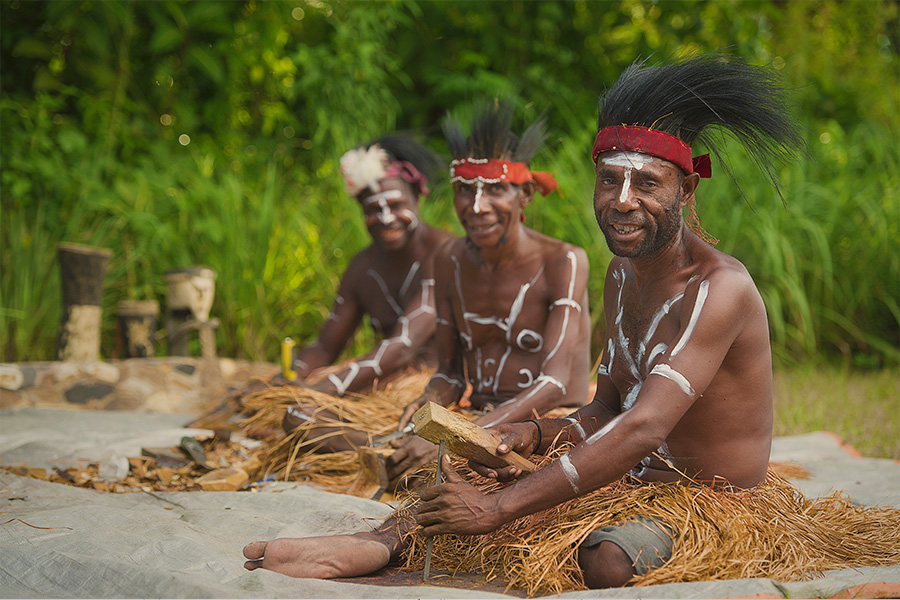28 March 2022

Hendrikus Wiriyu (33) has never counted the number of wooden statues he has carved. However, the young Kamoro tribe remembers eme aka tifa, a typical Papuan drum, as his first carving work when he was 17 years old. "I started carving after being initiated through karapao," said Hendrikus aka Hengky, on Friday, 18th March 2022 when met in Nawaripi Village, Wania District, Mimika Regency, Papua. Karapao is a major ritual of establishing customary rights for Kamoro boys to carry on their lineage traditions as carvers, dancers, singers for traditional rituals, or other roles.
As an initial task, eme cannot be taken lightly. He had to find his own colored wood in the forest, cut it into logs, sculpt, then carve motifs such as fish gills and rivers on the surface. The membrane of the drum was taken from the skin of a lizard. From time to time, Hengky's works are increasing. One by one the carvings were bought by the Capital City art collectors with a value of up to millions of rupiah. The intermediary is the Maramowe Weaiku Kamorowe Foundation, which means A Young Engraver, an organization that preserves Kamoro culture. “I used the money to buy chisels and carving tools. Now I focus on being an engraver,” said Hengky.
That afternoon in Nawaripi Village, at the carving workshop of the Maramowe Weaiku Kamorowe Foundation, Hengky was busy with a new work. Little by little he carved a piece of wood with a carving knife and hammer to form a boat, a miniature of the daily transportation of the Kamoro people. Previously, he also gave the final touch to a yamate or a 1.2 meter high wooden shield. The surface of the yamate is full of carvings, from the shape of turtle heads and shells, crab fingers, stars, crocodile skin, and fish gills, which are given various colors.
Herman Kiripi (43), Head of the Maramowe Foundation who is also an engraver, said that all the carving motifs symbolize food and everything related to the daily life of the Kamoro tribe. “Even though the motives are the same, the Kamoro people will never be the same when they make carvings. Every work is unique, there is always a difference,” he said. To color the motifs, Kamoro carvers only use natural dyes, as in Hengky's yamate. The red color, for example, is obtained from the small seeds of the fruit of watae or kesumba keling (Bixa orellana), while the green is from the leaves of vines, such as sweet potatoes.
With all its uniqueness, the tradition of carving is so full of meaning in the life of the Kamoro tribe. Like photos, said Herman, carvings of the Kamoro are intended for people to remember and immortalize their loved ones, such as their parents. In addition, various traditional rituals can only be performed with certain carvings. Karapao, for example, can only be accomplished if the mbitoro pillar full of carvings, from the human face to the wings at the top, has been standing. Making mbitoro, from the wood and roots of the kiiko tree aka kepuh (Sterculia foetida) is also accompanied by various sacred rituals since the tree felling. So, said Herman, carving can never be separated from the identity of the Kamoro people. “We must continue to make this (the art of carving) so that (tradition) it would be unbroken. That way, our children and grandchildren can participate in carving," he said.
Degradation
For the founder and companion of the Maramowe Foundation, Luluk Intarti, every Kamoro carving always has a soul and a story behind it. The resulting motifs can then be categorized as their use, which is as a reflection of daily life and for rituals. Even so, the art of carving had disappeared from the life of the Kamoro who inhabited the coastal area along 250 kilometers from Potowaiburu Village in Far West Mimika to Otakwa Village in Far East Mimika. It happened in the 19th century when the Dutch colonial government established outposts in Kokonao, West Mimika, and the Catholic Church.
The Dutch government established villages to stop the semi-nomadic pattern of the Kamoro people which hindered the collection of citizen data. In addition, traditional rituals, such as moving from mud to coastal land and karapao, which can take 1.5 years, are also prohibited. As a result, the art of carving disappeared along with these rituals. “If the ritual is lost, the carving no longer has any meaning so the Kamoro people stop carving. There was a degradation of the carving culture," Luluk said.
This situation persisted for years until the arrival of the American and Hungarian historian and anthropologist, Kai Muller, in 1996 to Kamoro Village. Luluk said, Muller saw the potential for Kamoro carving, which is also extraordinary, like among the Asmat tribe. Therefore, Muller initiated the Kamoro Kakuru cultural festival by asking for help from PT Freeport Indonesia (PT FI). This festival was then followed by various efforts to revitalize the Kamoro carving tradition, especially research, data collection, and training to revive the spirit of carving.
In addition, the team for revitalizing the carving culture, which was the forerunner of the Maramowe Foundation, also facilitated the marketing of works, first by establishing a carving gallery in Nawaripi Village. In addition, the team led by Muller also bridged marketing to art collectors, including in Jakarta and Bali, by holding exhibitions. “Mr Muller's work program to save the Kamoro culture has the full support of Freeport. Enthusiasm and pride to carve appeared again. As a result, the engraving is still there, the quality of the engraving is better. The number of artists also increased, especially the young ones. So, the regeneration is running,” said Luluk.
Approaching Muller's retirement in 2014, the Maramowe Foundation was established so that the work of cultural preservation would not stop. Now, the administrators of the foundation regularly come down once every three months to transport the works of the 25 villages inhabited by the Kamoro tribe to be marketed. Herman, Head of the foundation, said that this method makes it easier for carvers. They don't have to bother sailing by boat and taking the land route to Nawaripi to sell their carvings. “When we go down to the field to take the engraving, we usually give a DP (down payment/guarantee) first. For example, the price of carving is Rp. 600,000, we will give you a down payment of Rp. 300,000. After the carvings are sold, then we give the rest to the carvers so they don't stop carving, said Herman.
The difficult access to Kamoro villages due to the lack of infrastructure is the biggest challenge for the Maramowe Foundation today. However, Luluk said, all of this was possible thanks to PT FI's community development fund. "Every year at least up to Rp 4 billion, sometimes more," he said. Luluk assessed that the Kamoro cultural revitalization program is a success because of the great interest of the community to continue carving. He said that the indigenous Papuan tribes on the coast actually have a carving culture, both along the north and south coasts. However, this tradition now only survives in the Asmat, Sempan, and Kamoro tribes. "If it's Asmat carving, everyone knows. But not everyone knows about Kamoro culture. So, this is what we have to take care of, we help promote it," Luluk said.
The person in charge of the Kamoro cultural development program from PT FI Community Development, Reza Sofyan said that the company is responsible for maintaining local culture and wisdom. “We want young carvers to grow up. However, if the carver has no income, it is impossible for them to grow. So, we continue to help them so that they want to become carvers and can earn an income,” he said.
Kami menghimbau para pencari kerja untuk berhati-hati dan mewaspadai beragam modus penipuan perekrutan yang mengatasnamakan PT Freeport Indonesia. Dalam setiap proses rekrutmen dan penerimaan karyawan, PT Freeport Indonesia maupun konsultan rekruitmennya tidak memungut biaya apapun.
Untuk melihat lowongan, silakan akses melalui link berikut: ptfi e-recruitment
Untuk melihat informasi magang, silakan akses melalui link berikut: Internship Program
